Brilliance in Level Design: Ocarina of Time’s Forest Temple
Posted on January 03 2015 by Theodore Homdrom
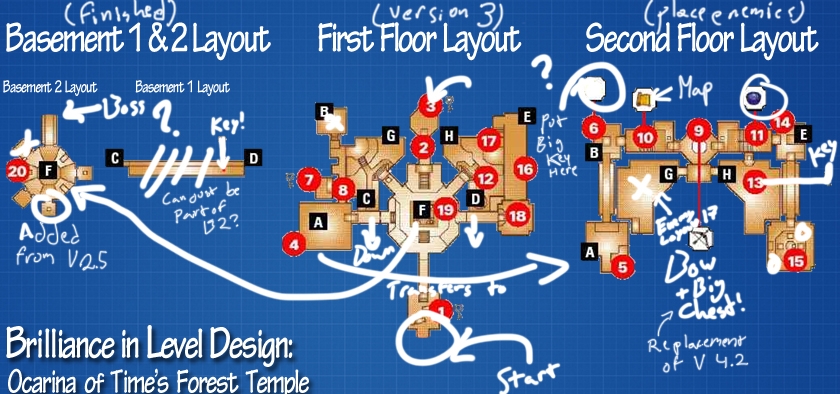 Hello everyone! For those who don’t know, this article is a continuation of a series started last week about level design in Zelda games. I’ll be looking at every single dungeon in these Zelda games: Link’s Awakening, Ocarina of Time, Wind Waker, Twilight Princess, Skyward Sword, and A Link Between Worlds, seeking to find which dungeons are examples of excellent level design, and then bringing that analysis to you fine folks.
Hello everyone! For those who don’t know, this article is a continuation of a series started last week about level design in Zelda games. I’ll be looking at every single dungeon in these Zelda games: Link’s Awakening, Ocarina of Time, Wind Waker, Twilight Princess, Skyward Sword, and A Link Between Worlds, seeking to find which dungeons are examples of excellent level design, and then bringing that analysis to you fine folks.
Today I’m talking about Ocarina of Time’s Forest Temple. I’ll be honest, I’ve never been a huge fan of the Forest Temple. It was okay, but only stood out to me because you get the Fairy Bow in it. Any dungeon in a Zelda game where you get the bow automatically sticks out to me for that reason alone. Otherwise, I wasn’t a big fan. However, the Forest Temple frequently comes up when people talk about favorite dungeons from Ocarina of Time, and even favorite Zelda dungeon in the entire series.
Since I’ve been replaying games seeking out great dungeons, it was a perfect opportunity to take a fresh look at Ocarina of Time’s Forest Temple. After playing through it with an open mind, I’m still not personally a fan of it, but I have much more appreciation for what it does right in terms of level design, which is quite a lot. Let’s dive in, shall we?
Objective-Focused Design
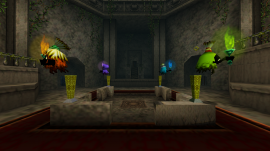 Within moments of entering the Forest Temple, you’ll find yourself in its hub room. Four torches are alight with four different colors of flame. Unfortunately, four Poes appear and steal the flames, and then disappear. This causes an elevator to drop into the floor, rendering it unaccessible.
Within moments of entering the Forest Temple, you’ll find yourself in its hub room. Four torches are alight with four different colors of flame. Unfortunately, four Poes appear and steal the flames, and then disappear. This causes an elevator to drop into the floor, rendering it unaccessible.
This, to me, is a fantastic opening for a dungeon. It immediately gives the player a sense of their objective. It isn’t the same as many other Zelda dungeons, giving you a more focused objective than the overarching “get the Boss Key, find the Boss Door, kill the boss, profit,” methodology for most Zelda dungeons. A central theme is given to this dungeon, stronger than in many others, because of this Poe system. You have four Poe sisters to track down to return the light to four different torches, in order to raise an elevator.
The entire level is designed around this, with every path branching out from this central hub, and the player frequently returning to this hub. The torches become lit after each Poe you defeat, so every time you return to the central room, you see clear evidence of your progress. Also, the idea of tracking down these Poes feels like I’m hunting my enemies, instead of them hunting me, which is a cool feeling in a Zelda game.
Welcome to the New World
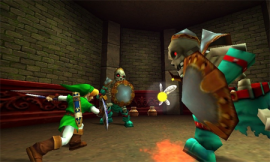 One of the reasons the Forest Temple is frequently lauded is that it shows a big departure from the dungeons you braved as Young Link. Seven years have passed, you’re an adult now (well, as much as a sixteen year-old is an adult), and the world has changed. This temple shows that right away.
One of the reasons the Forest Temple is frequently lauded is that it shows a big departure from the dungeons you braved as Young Link. Seven years have passed, you’re an adult now (well, as much as a sixteen year-old is an adult), and the world has changed. This temple shows that right away.
First of all, it’s bigger. There are more paths to explore, more doors to open, more enemies to fight, more puzzles to solve. There’s more ground to cover, and unless you know exactly what you’re doing, this dungeon won’t be completed in a breeze.
Secondly are the enemies. Sure, there are foes you’ve faced before: Skulltulas, Wolfos, Deku Babas and Octoroks. But a whole host of new enemies assails you throughout the dungeon. Stalfos are introduced, providing a challenging (for newcomers, at least) sword fight, giving the player more reason to tactically use their shield than they likely ever have up until this point. Bubbles, flaming skulls that float through the air, require you to extinguish their flames or hit them with projectiles.
Wallmasters and Floormasters are likely the most memorable foes to those who have played through this dungeon. Who didn’t freak out when they first saw that shadow grow larger, eventually revealing itself as a terrifying, disembodied hand that took them back to the start of the dungeon? I know I did.
Backtracking Done Right
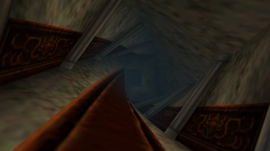 I’m a dummy.
I’m a dummy.
Every time I have played the Forest Temple, even after more than twenty times replaying Ocarina of Time, I always get lost and frustrated at the same part. On the way to getting the bow, you pass through a twisted corridor. There’s an eye switch over the door leading to it, but you can’t activate it because the only item you currently have that activates eye switches – the Slingshot – can’t be used in your adult form. So you pass the eye switch, go through the twisted corridor, get scared to death by the Wallmaster, fight some Stalfos, and yay! The bow!
One of the first things to do (after defeating two of the Poes you’re tracking in clever fashion) is go back to that eye switch, shoot it, and untwist the corridor.
I forget. Every. Single. Time.
I run around the Forest Temple like an idiot, using my Hookshot on everything in sight, playing the Scarecrow’s Song and Song of Time at every instance of Navi turning green, killing every enemy, and still don’t have the key I need.
This is not an instance of bad level design. After replaying the dungeon with fresh eyes, I’m certain of that. It is, however, a perfect example of me being a dummy. On that note, let’s talk about untwisting that corridor and the backtracking within this dungeon.
I don’t get the hate for backtracking in video games. Yeah, sometimes it’s done poorly (looking at you, Tales of the Abyss…), but sometimes it makes perfect sense. You go through an area, see things or places you can’t acquire or get to, and later, after you get an item or some such improvement, you come back and you can now do more in that area.
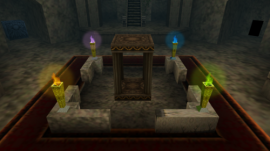 The Forest Temple involves a fair amount of backtracking, but I think it’s done really well. You clearly see the eye switch above the door, you probably try to hit it but don’t have any weapons that affect it, so you continue on. Maybe five minutes later, you get the Fairy Bow, and huzzah! You can activate eye switches now!
The Forest Temple involves a fair amount of backtracking, but I think it’s done really well. You clearly see the eye switch above the door, you probably try to hit it but don’t have any weapons that affect it, so you continue on. Maybe five minutes later, you get the Fairy Bow, and huzzah! You can activate eye switches now!
You also pass through a staircase en route to the bow that has one of the Poes you’ve been tracking in picture form. Whenever you approach the paintings, the Poe cackles and disappears. You can’t do anything to it. But then you have the bow, and coming back, what’s your instinct? If you think “Hey, I just got the bow, time to shoot everything!” then you’re on the right track. After three dungeons as Young Link, even a newcomer to Zelda games will have learned that once you gain the dungeon item, you should use it as much as possible.
Remember that hub room in the center of the dungeon? That’s why the backtracking works. You were given an objective from the very start, and everything was designed around a room that you would keep returning to until you’d hunted down every last Poe. You already know that you have to branch out from your main room to eventually open the path below. By giving the player that objective from the very start, the backtracking works.
Variety is the Spice of Dungeons
 You can’t accuse the Forest Temple of being one-note. There are so many new concepts (for Ocarina of Time, that is) introduced in this one temple alone, it’s astounding. There’s the twisting and untwisting corridors, the new enemies, the Poes and their fire. And yet there’s so many more ways in which the developers keep this dungeon exciting and new at every turn.
You can’t accuse the Forest Temple of being one-note. There are so many new concepts (for Ocarina of Time, that is) introduced in this one temple alone, it’s astounding. There’s the twisting and untwisting corridors, the new enemies, the Poes and their fire. And yet there’s so many more ways in which the developers keep this dungeon exciting and new at every turn.
Two of the Poes are defeated by shooting their paintings. The third has a timed block puzzle to make her appear. The fourth clones herself, challenging you to find the real Poe. Whenever a dungeon has a repeating mini-boss (*cough* Catfish’s Maw in Link’s Awakening *cough*), it’s always a good idea to make it a little bit different each time.
There is a lot of climbing in this dungeon. That’s probably because you have a shiny new Hookshot begging to be tested out. There are chests to grapple to, Skulltula tokens to reel in, and vines to ascend. While climbing is introduced in the very beginning of the game, the use of the Hookshot in tandem with climbable vines adds a new dimension to an old idea.
A section of the dungeon has a checkerboard floor, with a falling ceiling that will crush you if you stand in the wrong place. Unfortunately, nearly every safe zone has a Skulltula waiting to drop down and push you into a flattening demise. This section is made all the more exciting by the fact that you can hear when the ceiling is falling, adding a sense of urgency to your already precarious predicament.
The section of the dungeon leading to the boss has a rotating roulette. Push a section of the wall to rotate the room, opening up switches, a room with a Gold Skulltula, and eventually, the Boss Door itself.
There are so many new ideas thrown at the player, and yet it’s done in such a great way. New enemies are introduced in safer environments before throwing more of them at you in more dangerous situations. New puzzles or traps are introduced with plenty of the time for you to take stock of your surroundings and devise a solution. This dungeon will test your cleverness and resourcefulness, rather than your reflexes and memorization. That’s a plus for any Zelda dungeon in my book.
Phantom Tennis
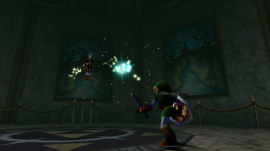 Finally, we have the boss: Phantom Ganon. This makes great use of two concepts already introduced in this dungeon: shooting paintings, and deciphering who’s real among clones. Phantom Ganon will ride through paintings, but one will usually be a clone. It’s up to you to figure out who’s who, and shoot the real Phantom before he bursts out of the painting and blasts you with magic.
Finally, we have the boss: Phantom Ganon. This makes great use of two concepts already introduced in this dungeon: shooting paintings, and deciphering who’s real among clones. Phantom Ganon will ride through paintings, but one will usually be a clone. It’s up to you to figure out who’s who, and shoot the real Phantom before he bursts out of the painting and blasts you with magic.
What really stands out in terms of this boss’s design, however, is the second phase. Phantom Ganon loses his horse and flies around the room, firing balls of energy at you. Hit them back at him with your sword for a high-stakes game of tennis, until he succumbs to his own magic and falls to the floor, where you can hit him with your sword.
This phase isn’t all that remarkable on its own, but rather for the foreshadowing it does. When you finally get to Ganon’s Castle and fight the real Ganondorf, you’ll be playing another game of tennis. This boss fight prepares you for that, and the fact that you’re fighting “Ganondorf” in this fight as well as the final fight makes that connecting thread between the two battles that much clearer.
Conclusion
Even after replaying it for this analysis, the Forest Temple is still not a highlight for me. But looking at it with fresh eyes showed me that my personal feelings for this particular dungeon are not because of lackluster level design. The Forest Temple really shines in that regard. New enemies, a great transition from Young Link’s dungeons to what you’ll face as Adult Link, and a slew of new puzzles and traps that are incredibly intuitive makes this dungeon a fantastic example of great level design.
For those curious about what makes the points above marks for “brilliance” in level design, here’s sort of how I look at the levels, in a series of questions I ask as I play through these dungeons:
- Is the dungeon layout intuitive? (i.e. will the player get unnecessarily lost or confused because of poor level design?)
- Does the dungeon teach the player?
- How does it match up with the game as a whole?
Great levels, in my opinion, are fair. Unnecessary difficulty, like needing to memorize the dungeon to avoid deaths, are not okay in my book. They should also teach the player, introducing new concepts in controlled environments, but then combining them in interesting ways later on or placing them in more dangerous environments to challenge the player to expand on what they’ve learned. They should also fit within the themes and progression of the game, building on what has come before that point, and preparing the player for what comes next.
The Forest Temple is a transitional moment for the player. You’ve just drawn the Master Sword, turned into an adult, and been thrown into a much more dangerous Hyrule. The Forest Temple is a great example of that, upping the difficulty and showing off new enemies, traps, and puzzles. It’s also the first instance in Ocarina of Time of a “Boss Key” and “Boss Door,” informing the player that the three dungeons before this moment were lesser, “child’s play,” if you will.
The Forest Temple is perfectly fair in its difficulty, and my own instance of frustration is not, I would expect, common to the average player. It’s just me being a dummy. I hope you’ve enjoyed this analysis, and feel free to voice your agreement or dissent in the comments below! Also, let me know what are some of your favorite dungeons in the Zelda series, and if you would like me to take a closer look at any dungeon from the games I will be playing for this series of articles. Until next time, thanks for reading, and enjoy your dungeon-crawling adventures!
Previous dungeons analyzed:



